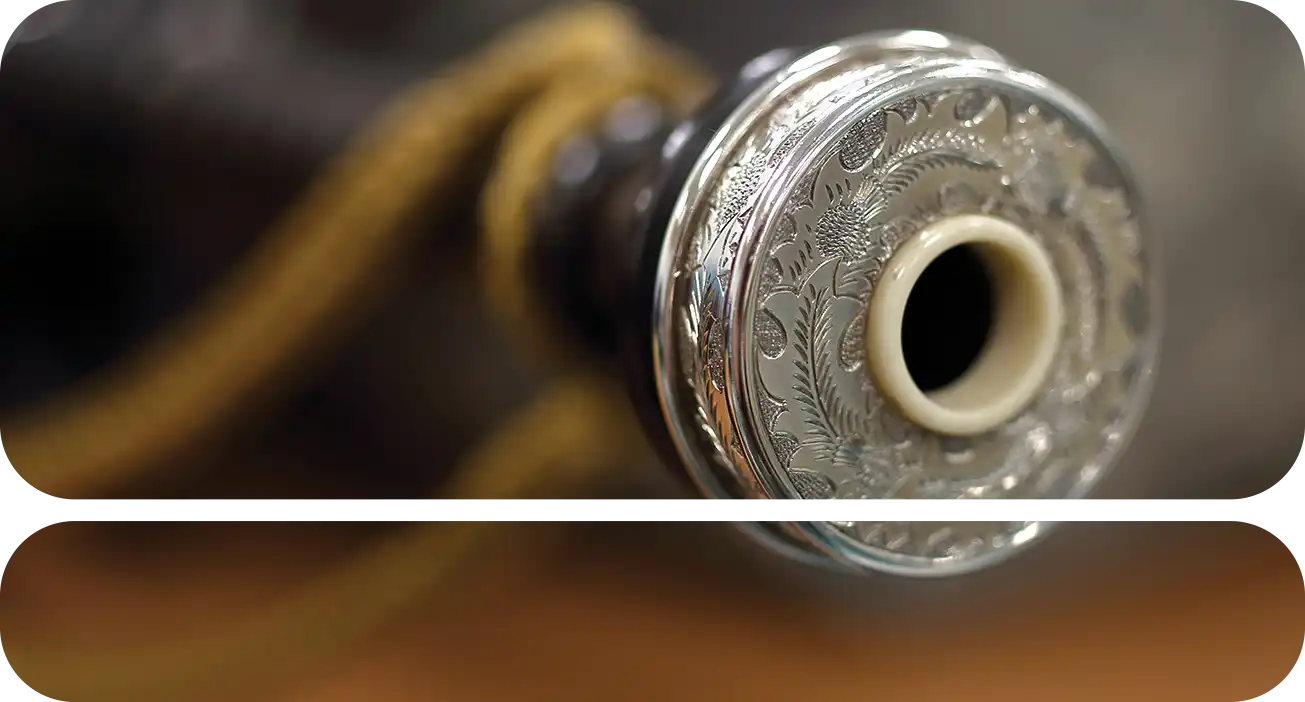



Pìobaireachd, the classical music of the Highland Bagpipe, reached the present by a long and complicated route. For many years It existed within a predominantly oral setting, before being committed to paper by a distinguished series of piper-editors during the nineteenth century, including amongst numerous others Donald MacDonald (c.1767-1840), Angus MacKay (1813-1859) and David Glen (1853-1916). Growing musical literacy and cheapening paper encouraged many master players to record their repertory in manuscript form, as an aide-memoire and a resource for teaching and learning. Several of them used these documents as a basis for a formal published collection. By the early 1900s, virtually the whole of the pìobaireachd repertory had found its way into attractive and affordable printed form. But as the twentieth century advanced, access to this heritage became difficult. Many of the major manuscripts were acquired by a wealthy private club, the Piobaireachd Society founded in 1903, and the chief published collections including those of MacKay, MacDonald, Glen, C. S. Thomason, Donald MacPhee, and William Ross, went out of print, partly as a result of the Society’s policy of publishing at below cost. Scottish libraries tended not to acquire bagpipe music at all, so the vacuum was filled by the published scores of the Piobaireachd Society, currently occupying sixteen volumes and containing some two hundred and sixty tunes, either edited directly by--or governed by the eccentric musical tastes of--a single man: Archibald Campbell, Kilberry, (1877-1963). This effectively replaced the variety and musical coherence of former days with a unitary prescriptive score of questionable musical value.
The manuscripts eventually returned to the public domain, (mainly to disappear yet again into the special collections of great libraries under restricted access), and a number of the classic published editions were briefly reprinted during the nineteen seventies. But it remained difficult to survey the different versions of a given tune for study or performance or to form a true picture of the nature and extent of what had been available in the past. The arrival of the internet, and more particularly of broadband, dramatically changed that. Suddenly it was possible to assemble all the authentic written and printed scores, to compare and contrast them, and to present them online with a commentary. At about the same time that the great online editions of the manuscripts of Mozart, Bach and Beethoven were being posted to the net (eccentric editing had also affected the “official” Mozart and Beethoven editions), the “Set Tunes” series began the laborious process of digitising pìobaireachd, hosted by the leading piping e-zine, pipesdrums.com of Toronto.
Each year from 2001 onwards, as the annual tunes were given out by the Piobaireachd Society which determined what was heard at the great public competitions, the “Set Tunes Series” presented the authentic versions preserved in the original manuscript and early published collections. The Series had by 2024 reached almost two hundred tunes, and contained virtually all the great canonic pieces. For much of this period also the PDF files containing the musical and verbal text have been supplemented by audio recordings prepared by the editor indicating how the scores might be interpreted and drawing attention to the frequent differences between the idiom these suggest and what is commonly heard in public today. This was a task of some difficulty. At first the musical examples were freshly typeset from transcriptions made of the originals in order to avoid potential copyright difficulties. Then, when it became clear that the great libraries of Scotland were willing to support the venture, it became possible to reproduce digitised scores, or parts of scores, taken directly from the original manuscripts themselves. This created a further difficulty, however. These were essentially private documents, whose penmanship varied widely—and it was obvious that they had been intensively used. They were sometimes dirty, there was the occasional smudge and spill, they bore evident marks of the passage of time. Would modern players, unaccustomed to the medium, be swayed by their shabby appearance and question the authority they in fact possessed? Some MSS were relatively clean; but others required attention to restore them to their original condition. For example in Donald MacDonald’s Manuscript, one of the oldest—many pages had to be cleaned electronically. Loaded into Microsoft’s “Paint” programme and blown up to a high resolution, the debris of centuries was painstakingly removed. It was exacting work. A single page could take an afternoon to clean. As time passed and the Set Tunes Series became established it was possible to relax this regime with considerable saving of time.
The present website, Pìobaireachd (Pibroch)—the Classic Scores—reproduces entire the original material from the Series from its inception in 2001 to 2023. A number of the older files have been updated to make them conform to the conventions which later became standard, and MP3 recordings have been prepared for virtually all of the tunes.


The apparatus of the Piobaireachd Society Collection (second series, 16 vols. 1925-- ) and its accompanying abridgement The Kilberry Book of Ceol Mor (1948; 3rd edn. 1970) suggested scrupulous scholarship and accuracy, and indeed Archibald Campbell’s arrangements were published by the society as the authentic stylings of great traditional musicians. Campbell worked alone, independently of the Society’s Music Committee in whose name his scores were published; indeed it is doubtful if they ever actually saw the autocratic editor’s work prior to publication. The editorial papers showing in detail how each score was evolved were eventually deposited in the National Library of Scotland and detailed examination of them revealed how Campbell intervened freely, although silently, in the sources. He removed instructions to repeat parts, added movements not present in the originals, reduced varied conventional movements to standardized single forms, and exaggeratedly prolonged note values, claiming--without foundation--the sanction of numerous traditional master pipers for what were essentially his own idiosyncratic personal settings. Although he had ready access to expert advice from leading players on how the music should be set, he seldom followed it. By 1938 senior members of the Music Committee proposed abandoning his work as “most flagrantly wrong” (William Donaldson, The Highland Pipe and Scottish Society, p. 396). Campbell's only surviving teacher, the great piper John MacDonald of Inverness, wrote that “our ancient and traditional music, with all its beautiful and melodious airs and sentiment, has passed into the wrong hands, and it will take a long time, if ever, before it can be restored to its original standard” (ibid., 397). In the face of mounting private and public hostility to his work, Campbell described volume 8 (1939) as his last, and the second series went temporarily out of print.
But during the war years Campbell consolidated his position, and in 1948 the Piobaireachd Society of Scotland published his personal anthology The Kilberry Book of Ceol Mor containing 114 tunes prefixed by a historical and textual “Introduction”. The scores showed further corruption of time values, reflecting Campbell's belief that “slowness is a characteristic of Highland music” (Archibald Campbell, Kilberry Book, p.6) and his preference for “heavy” rather than “tune-y” pieces (Seumas MacNeill and Frank Richardson, Piobaireachd and its Interpretation, 112–15). The introduction gave a sketch of the leading piping families, presenting the MacCrimmons as the source of all authenticity. It stated that piping had been saved by the army and the Highland Societies of London and Scotland and that the piobaireachd tradition had effectively come to an end with Angus MacKay. Although little evidence was offered for many of the key points, Campbell's essay became the standard source of conventional wisdom during the second half of the twentieth century. By 1950 “Archie Kilberry” had established himself as the leading authority on pìobaireachd. His scores were fixed texts for all important competitions, and following his death in 1963, later editors of the Piobaireachd Society faithfully followed the house-style he had created. This changed the way in which the music was perceived, as pipers, whose light-music repertories demonstrated vigorous musicality, gradually came to believe that pìobaireachd was characterised by a strange distortion or even absence of melody. Some sought purity of idiom in such orally transmitted teaching as still seemed to survive; but this too had been significantly affected by the Society's scores. By the 2000s three generations of pipers had won their standing playing Campbell's scores, in the belief that these were the stylings of master musicians like the MacCrimmons, MacKays, and Camerons. The worldwide expansion of piping in the second half of the twentieth century made his Kilberry Book in the words of his son and successor, James Campbell, “the biggest selling piobaireachd book ever produced”. (James Campbell, “The Story of the Kilberry Book of Ceol Mor”, Piping Times, 53/5, 22).
The all-embracing institutional structure which lay behind this ensured that performance, teaching, and career opportunity took place within a context defined by Archibald Campbell’s work. Now technical change presents us with a chance to undo some of the damage done by a tragic combination of wrong-headed and dishonest editing backed by irresponsibly-wielded social power.